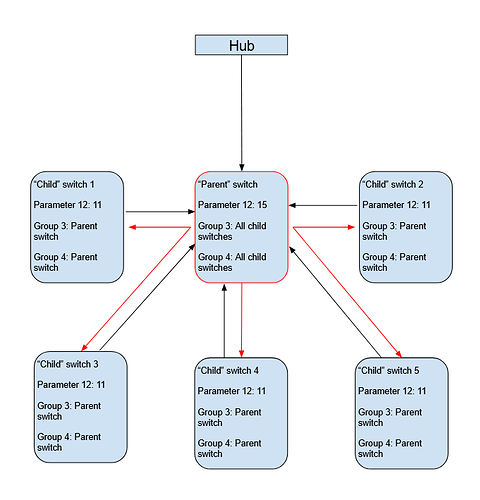Association group 1 (Lifeline): This is the device your switch communicates status updates to. It is set automatically when you include the dimmer, and should almost always point to your hub.
Association group 2 (Basic Command Class): This is used to send basic on/off/dim commands to another device. Almost all devices support this type of command. It can be used to send on, off, or a dim level, but does not support dimming duration, and does not allow you to hold the button down to gradually dim a device.
Association group 3 (Multilevel Switch Command Class): This is also used to send on/off/dim commands, but includes additional features. This command class supports dimming duration. It also allows you to do gradual dimming by holding the buttons down (however, the Inovelli dimmers moved this functionality to Association group 4). Not all devices support this command class. For example, the Inovelli Switches (not dimmers) do not support this, so you should use Association Group 2 instead of 3 if you were trying to control them.
Association Group 4 (Multilevel Switch Command Class). This is the same command class as group 3, but is only for the gradual dimming functionality you get when holding down the buttons on the dimmer.
The Inovelli dimmers also support a form of command forwarding. Whenever you control the dimmer (either from your hub, the physical buttons, or from another zwave device), it will attempt to forward that command to any devices in Association groups 3 and 4 based on the source of the command and the value set in config parameter 12:
| Parameter 12 |
Command will be forwarded when received from |
| 0 |
No commands will be forwarded |
| 1 |
Physical button presses |
| 2 |
3-way addon module button presses |
| 3 |
3-way & physical |
| 4 |
zwave (either from hub or from another device) |
| 5 |
zwave & physical |
| 6 |
zwave and 3-way |
| 7 |
zwave, physical & 3-way |
| 8 |
timer (auto-off timer in parameter 8) |
| 9 |
timer & physical |
| 10 |
timer & 3-way |
| 11 |
timer, 3-way & physical |
| 12 |
timer & zwave |
| 13 |
timer, zwave & physical |
| 14 |
timer, zwave & 3-way |
| 15 |
all |
The default value for parameter 12 is 15, meaning it will forward any command it receives from any source to all devices in Association group 3/4. If we dont change this parameter value when setting up a virtual 3-way, we will get an infinite loop. Dimmer 1 will forward command to dimmer 2, which will forward it back to dimmer 1, which will forward to dimmer 2, etc.
Setting Parameter 12 to value 11 on all devices in the virtual 3-way except the “master” device will prevent the infinite loop. If Dimmer 1 is the master:
- Pressing the physical button on Dimmer 2 will cause the command to be forwarded to Dimmer 1 via zwave. Dimmer 1 will forward the command back to Dimmer 2, but thats as far as it goes (Dimmer 2 will not forward commands received via zwave). At this point, devices are in sync.
- Pressing the physical button on Dimmer 1 will cause the command to be forwarded to Dimmer 2 via zwave. Since Dimmer 2 does not forward zwave commands, it stops there and all devices are in sync.
- Setting Dimmer 1 via zwave from the hub will cause the command to be forwarded to Dimmer 2 via zwave. Since Dimmer 2 does not forward zwave commands, it stops there and all devices are in sync.
- Setting Dimmer 2 via zwave will NOT cause the command to be forwarded to Dimmer 1. Devices will not be in sync. This is why you only want to control the “master” dimmer, and let it forward the commands to keep devices in sync.
An added benefit to this method is that the devices all communicate directly with each other without going through the hub first. This causes everything to both run faster, and it will still work if the hub goes offline.

